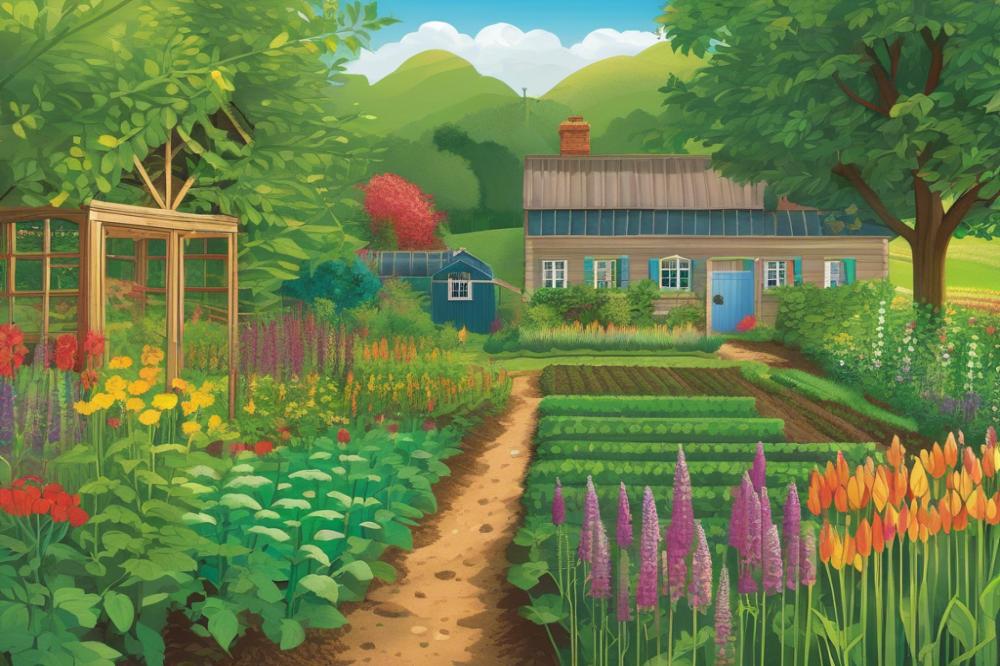How to Use fertilizers Safely Around fertilizers-for-hydroponic-gardening”>pets and wildlife
Gardening can be a rewarding hobby. Many find joy in cultivating beautiful gardens and lush lawns. However, safety is an essential aspect of this endeavor. Using safe fertilizers is crucial for protecting not only plant health but also the well-being of our beloved pets and wildlife. As we spread nutrients across our gardens, we must consider how these substances can affect those living around us.
Concerns about pet safety and wildlife protection arise with the use of both organic fertilizers and chemical fertilizers. Chemical substances may lead to harmful effects on animals if ingested or if they come into contact with treated areas. Pets, with their curious nature, often explore their surroundings. This instinct can expose them to harmful chemicals that are typically found in non-toxic fertilizers. Wildlife faces similar risks, as they roam freely through treated gardens and lawns.
Responsible fertilizer application practices are paramount. Opting for organic fertilizers is one way to minimize potential hazards. These products offer a natural approach to nutrient delivery and typically pose fewer risks to animals. Moreover, pet-friendly gardening methods can help maintain a healthy environment without jeopardizing lives.
The environmental impact of widespread chemical use also worries many gardeners. safe fertilizers can help create a more balanced ecosystem while being mindful of the various creatures inhabiting our gardens. Taking the time to consider the safety of both pets and wildlife allows for an enriching gardening experience without unnecessary risks. Understanding these factors can lead to a thriving garden that benefits everyone involved.
Understanding Safe Fertilizers


Definition and Types of Safe Fertilizers
Fertilizers play an important role in plant growth. They provide essential nutrients that enrich the soil. There are various types available, and some are definitely safer for pets and wildlife. Organic fertilizers come from natural sources such as manure, compost, or plant material. These options enhance soil health while minimizing risks to animals. Chemical fertilizers, on the other hand, are manufactured and often contain synthetic compounds. While effective for rapid growth, they carry elevated risks for pet safety and wildlife protection.
Comparison of Organic Fertilizers and Chemical Fertilizers
When comparing these two categories, consider their impact. Organic fertilizers slowly release nutrients, which is better for long-term health. Pets may ingest these materials without facing immediate threats. Chemical fertilizers act quickly but can lead to chemical burns or poisoning if consumed by pets. Additionally, the runoff from these products can harm local wildlife. Organic choices often improve overall soil structure, while chemicals can degrade it over time. Ultimately, the selection of fertilizer affects both your lawn care efforts and the surrounding ecosystem.
Benefits of Using Non-Toxic Fertilizers
Non-toxic fertilizers contribute positively to garden safety and environmental impact. They provide a chance for pet-friendly gardening practices. Healthy plants flourish without putting your beloved pets at risk. Using safer options can also promote biodiversity in local habitats. Beneficial insects and wildlife can thrive when harmful chemicals are avoided. These fertilizers reduce environmental risks while fostering sustainable gardening. Incorporating them leads to thriving gardens and peace of mind for pet owners. Always prioritize what’s best for both your plants and the creatures that share your space.
Pet Safety and Garden Fertilizers


Common fertilizers that are harmful to pets
Chemical fertilizers can pose significant risks to pets. Many contain ingredients like nitrogen, phosphorus, and potassium, which are toxic if ingested. Fertilizers with herbicides or pesticides are especially dangerous. Some organic fertilizers, while less harmful, may still include substances like bone meal or blood meal that attract pets. Pets exploring the garden can accidentally consume these fertilizers. Lawn care items mixed with chemicals can also create hazards. Always read labels to identify ingredients that may endanger your furry friends.
Signs of fertilizer poisoning in pets
Recognizing signs of fertilizer poisoning early can save a pet’s life. Symptoms include vomiting, diarrhea, and excessive drooling. In some cases, pets may experience lethargy or unusual behavior. Severe reactions might lead to tremors or seizures. Keep an eye out for any changes in your pet’s routine after they spend time outdoors. Quick action can make a difference. If you suspect your pet has ingested fertilizer, contact a veterinarian immediately. They can provide guidance on the next steps to take for your pet’s health.
Precautionary measures to protect pets during fertilizer application
Practicing garden safety is essential when applying any type of fertilizer. One effective strategy is to confine pets to an area away from your lawn care activities. Covering treated areas with tarps can keep curious animals away while protecting wildlife too. Use non-toxic fertilizers whenever possible to minimize risks. Inform family and friends about your gardening schedule to avoid accidental exposure. During fertilizer application, avoid peak activity hours when pets are most likely to be outside. Ideally, you should restrict access until rain or watering washes away any residues. Make pet-friendly gardening a priority to ensure your yard remains a safe space for all.
Wildlife Protection and Fertilizer Use


Impact of Chemical Fertilizers on Local Wildlife
Chemical fertilizers can harm local wildlife in various ways. When applied to lawns and gardens, they may run off into nearby water sources, impacting aquatic life. Excessive nutrients from these products can create algae blooms, depleting oxygen and harming fish populations. Birds and other animals may ingest harmful substances through contaminated soil or plants. Understanding these risks is critical for anyone who values the local ecosystem.
Best Practices to Minimize Environmental Impact
To reduce the environmental impact of fertilizer application, consider adopting some best practices. First, choose organic fertilizers when possible. These non-toxic solutions nourish the soil without the harsh chemicals adverse to wildlife. Applying smaller amounts throughout the growing season can be effective and safer for your surroundings. Timing is essential; fertilizing during dry periods prevents runoff from heavy rain. Always water your garden properly to help nutrients absorb effectively without excess drainage.
Creating a Pet-Friendly Gardening Environment with Wildlife in Mind
Creating a pet-friendly gardening environment involves thoughtful planning. Use plants that are safe for pets, avoiding any known toxic species. Design your gardening spaces with native plants that attract beneficial wildlife. This approach enriches biodiversity and provides shelter for local creatures. Regular lawn care is important, but try to limit the use of synthetic products. Instead, focus on maintaining healthy soil and nurturing your plants organically. Remember, a vibrant garden can thrive without harming pets or wildlife.
Correct Fertilizer Application Techniques


Timing and Methods for Safe Fertilizer Application
Applying fertilizer at the right time can make a big difference. Early morning or late afternoon is best for most garden and lawn care tasks. It helps minimize the risk of evaporation and damage. Rainy days should be avoided unless you’re using organic fertilizers. Wet conditions can wash away nutrients and lead to runoff, which harms local wildlife. Consider using granular products, as they can be more controlled compared to liquid forms.
Importance of Following Manufacturer’s Instructions
Always read the label before beginning fertilizer application. Different products have varying guidelines on how much to use and how often to apply it. Misapplication can lead to chemical buildup in your soil and potential harm to pets and local animals. Research shows that sticking to the recommended amounts can reduce the environmental impact. Every product comes with specific instructions to protect both your plants and nearby wildlife. Ignoring these directions might not only waste resources but also create unsafe conditions for your furry friends.
Strategies for Application in Areas Frequently Visited by Pets and Wildlife
When mowing the lawn or tending to the garden, be aware of your surroundings. Create buffer zones away from areas where pets play and wildlife roam. This limits direct exposure to chemicals. Consider using non-toxic fertilizers that are safer for both pets and the environment. They help maintain garden safety without the risks associated with harmful substances. Spreading fertilizers evenly helps avoid excess accumulation in specific spots.
Always allow time for the product to settle before letting pets back into the treated areas. Dogs and cats are naturally curious and might lick up substances if they feel the urge. Mixing your application with water can help minimize risks. It reduces the likelihood of residue left on grass blades or soil surfaces. Lastly, keep a close eye on local wildlife. Watch for any signs that they may be affected, and adjust your practices if necessary. Your efforts in pet-friendly gardening will benefit both your garden and the environment.
Lawn Care and Fertilizer Safety
Taking care of your lawn can be a rewarding experience, especially when you’re considering the safety of your pets and local wildlife. When applying any lawn products, you should think about pet safety first. Pets often roam around and play on the grass, and their health is a priority. Always verify that pets are kept away during fertilizer application to prevent any possible ingestion or contact with harmful substances.
Specific Considerations for Lawn Care Around Pets
Understanding the potential risks that some fertilizers pose to animals is crucial. Chemical fertilizers can contain ingredients that may be toxic to pets. This poses a risk not only through direct ingestion but also through skin contact. Look for signs of discomfort in your pets if they have been on treated areas shortly after application. Consistently keeping pets off treated lawns for 24 to 48 hours is wise until any applied product has had time to settle and dry.
Choosing Pet-Safe Lawn Care Products
It is vital to select non-toxic fertilizers that will maintain lawn health without risking pet well-being. Research shows that organic fertilizers are often the best option. These products tend to be less harmful and promote a vibrant lawn while being safe for wildlife protection. When browsing for lawn care products, check the labels for pet-friendly gardening certifications. These indicators can help you avoid harmful chemicals that threaten both pets and the environment.
Maintaining a Healthy Lawn Without Harmful Fertilizers
Keeping your lawn lush and healthy can be accomplished with a few eco-friendly methods. You may consider composting as an alternative to chemical fertilizers. Compost enriches the soil naturally and helps to retain moisture, reducing the need for synthetic options. Also, applying mulch can enhance soil health, aiding in weed control while remaining safe for curious pets and critters. Regularly aerating your lawn allows nutrients to penetrate deeper, resulting in a stronger root system without additional chemical applications.
Incorporating proper lawn care practices goes a long way. Regular mowing and watering create a resilient lawn. Choosing drought-resistant grass types can help protect against over-fertilization. By doing so, you can create a balance that benefits your lawn while considering the health and safety of your pets and local wildlife.
Wrapping It Up
Recapping the key points about fertilizer use is essential for both pet safety and wildlife protection. Choosing the right products can make a significant difference. Always read labels carefully and look for those that are environmentally friendly. Understanding the proper application methods is also crucial. This minimizes risks, not just for animals but for the ecosystem as a whole.
Adopting pet-friendly gardening practices can transform your outdoor space into a safe haven. Consider shifting towards organic options, which can enrich the soil while keeping your furry friends secure. Keeping pets away from treated areas until it’s safe can be a simple yet effective precaution.
Select and use safe fertilizers to promote a healthier environment. When you opt for safer choices, you contribute to the well-being of birds, squirrels, and other wildlife. It’s a small change that carries great importance. By being mindful, you can create a thriving garden that supports both plant life and the animals that share our world.



